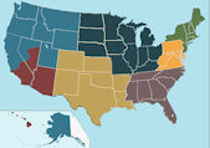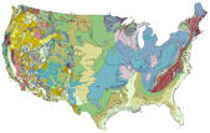
US Geography: The Land
Geography, Landscape, and Landforms of the US
Geography Regions: Physiographic Areas, Landscape, & Landforms
Find an overview of US geography, topography, geographic land regions, land areas, and major rivers. Access US almanac furnishing more details on state geography, geographical and land regions, climate and weather, elevation, land areas, bordering states, and other statistical data. Jump to Quick Facts on US Geography
The United States is a nation in the Western Hemisphere. It consists of forty-eight contiguous states on the North American continent; Alaska, an enormous peninsula which forms the northwestern most part of North America, and Hawaii, an archipelago in the Pacific Ocean. It also holds several United States territories in the Pacific & Caribbean. The country shares land borders with Canada and Mexico and a water border with Russia.
Forty-eight of the States are in the single region between Canada and Mexico; this group is referred to, with varying precision and formality, as the continental or contiguous United States, and as the Lower 48. Alaska, which is not included in the term contiguous United States, is at the northwestern end of North America, separated from the Lower 48 by Canada. The State of Hawaii is an archipelago in the Pacific Ocean. The capital city, Washington, District of Columbia, is a federal district located on land donated by the state of Maryland.
(Virginia had also donated land, but it was returned in 1847.) The United States also have overseas territories.
In the study of geography two main branches may be distinguished, physical geography and human Geography (or cultural) geography, originally anthropogeography. The first, based on the physical sciences, studies the world's surface, the distribution, delineation, and nature of its land and water areas. Climate, landforms Geography (see geomorphology), and soil are examined as to origin and are classified as to distribution. Find images, descriptions, and a overview of the geography, topography, geographic land regions, land areas, and major rivers in each state.
Physiographic Areas are effective and sensible conservation planning units because vegetative communities, bird populations, and species assemblages, as well as land use and conservation issues, tend to be more uniform within than across these areas.
- Alabama Geography
- Alaska Geography
- Arizona Geography
- Arkansas Geography
- California Geography
- Colorado Geography
- Connecticut Geography
- Delaware Geography
- Florida Geography
- Georgia Geography
- Hawaii Geography
- Idaho Geography
- Illinois Geography
- Indiana Geography
- Iowa Geography
- Kansas Geography
- Kentucky Geography
- Louisiana Geography
- Maine Geography
- Maryland Geography
- Massachusetts Geography
- Michigan Geography
- Minnesota Geography
- Mississippi Geography
- Missouri Geography
- Montana Geography
- Nebraska Geography
- Nevada Geography
- New Hampshire Geography
- New Jersey Geography
- New Mexico Geography
- New York Geography
- North Carolina Geography
- North Dakota Geography
- Ohio Geography
- Oklahoma Geography
- Oregon Geography
- Pennsylvania Geography
- Rhode Island Geography
- South Carolina Geography
- South Dakota Geography
- Tennessee Geography
- Texas Geography
- Utah Geography
- Vermont Geography
- Virginia Geography
- Washington Geography
- West Virginia Geography
- Wisconsin Geography
- Wyoming Geography
Quick Facts on US Geography
- Michigan is made up of two large, unconnected (except for a bridge) peninsulas.
- Alaska has the longest coastline
- Kentucky is the only state to have a portion of its land completely surrounded by other states. Tennessee and Missouri surround part of Kentucky because of a bend in the Mississippi River.
- Colorado and Wyoming are bounded by two circles of latitude and two meridians each, i.e. they appear to be rectangles in a cylindrical map projection.
- Colorado, Utah, and Wyoming are the only states whose borders are made up of only straight lines (taking meridians and circles of latitude as straight lines) and, thus, the only states whose borders completely ignore natural features.
- Every state- except Hawaii, which has no land boundaries- has straight lines as at least part of its boundaries. These are usually combined with rivers, ridge lines, and other natural boundaries. Pennsylvania and Delaware are unique in that their common border is an arc of a circle.
- The lower peninsula of Michigan is shaped like a mitten; Louisiana is shaped like a boot; Oklahoma is shaped somewhat like a cooking pot when viewed from the side. The western border of Montana strongly resembles the profile of a face.
- Alaska, Connecticut, Florida, Idaho, Maryland, Nebraska, Oklahoma, and Texas have panhandles. West Virginia has two panhandles.
- Alabama, Missouri, New Mexico, and Mississippi have boot heels.
- Alaska and Hawaii are the only states that are not physically connected to other states; Maine is the only state that borders only one other state (New Hampshire). Missouri and Tennessee each border eight other states, the most for any state.
- Arizona, New Mexico, Colorado, and Utah are the only four states to share a common border, known as the "Four Corners."
- Oklahoma's Cimarron County is the only county in the United States to border four other states: Texas, New Mexico, Colorado, and Kansas.
- Contrary to appearances given by the stereographic projection, Minnesota is the northernmost of the forty-eight contiguous United States. A northern spur of the state, the Northwest Angle, contains a portion of Lake of the Woods. At one time, it was thought that Lake of the Woods contained the headwaters of the Mississippi River (which are now known to be at Lake Itasca).
- Washington and Minnesota are the only states where access between portions of which is only possible through another country. Point Roberts, Washington, is the tip of a peninsula from British Columbia, Canada, that extends south of the 49th parallel north to fall within US territory. The only land access to Minnesota's Northwest Angle is by going through Canada. Neither has a bridge connecting them with the rest of the United States.
- Alaska is the northernmost state and the westernmost state. Some would argue that it is also the easternmost state, as the Aleutian island chain crosses the 180º line of longitude.
- The southernmost point is Ka Lae, Hawaii; Ballast Key, Florida, is the southernmost point in the contiguous 48 states. Key West is sometimes incorrectly believed to hold the later distinction, since Ballast Key is privately owned, while Key West has a large population. Key West is indeed the southernmost city in the 48 contiguous states, and contains the southernmost point visited by the general public.





